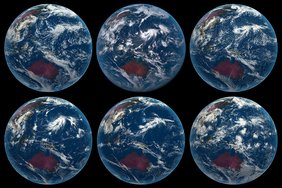The water vapor content of the troposphere has a strong impact on the Earth’s radiation budget and exerts a positive climate feedback. This is a process in the climate system that amplifies the warming triggered by an increase in CO2 concentrations. The strength of this feedback depends on how the relative humidity (which measures the water vapor pressure relative to the value at which condensation sets in at the current temperature) changes under warming. Therefore, it is crucial that climate models reliably simulate the distribution of relative humidity and its change under warming. However, there is considerable uncertainty in both aspects in conventional climate models, which manifests as a large inter-model spread.
In this study the authors investigate for the first time, how large humidity differences are across global storm-resolving models with kilometer-scale horizontal resolutions. They make use of the DYAMOND initiative, a first intercomparison of 40-day storm-resolving simulations with nine different models.
They find that the disagreement in tropical humidity is reduced in the storm-resolving models compared to conventional models with coarser resolution. This nourishes hopes that the strength of the water vapor feedback is also better constrained in these models – an assumption that has to be verified as soon as longer high-resolution simulations are available.
However, the authors also show that the remaining humidity differences have a considerable impact on the clear-sky (cloud-free) radiation budget of the storm-resolving models, particularly those in the mid troposphere (~ 1-10 km altitude). Furthermore, two tropical regimes are of particular importance: relatively moist regimes in the vicinity of deep convection, as well as very dry subsidence regimes. Ultimately, humidity differences in the dry regimes matter most since high clouds, which mask the radiative effect of water vapor, are rare in these regions. Hence, from a radiative perspective a further reduction of the uncertainty in humidity would be most beneficial in these regions. The study therefore highlights the need to better understand the processes that control the humidity in these regions and cause the model differences.
Original publication:
Lang, T., Naumann, A.K., Stevens, B., & Buehler, S.A. (2021). Tropical free-tropospheric humidity differences and their effect on the clear-sky radiation budget in global storm-resolving models. Journal of Advances in Modeling Earth Systems, 13, https://doi.org/10.1029/2021MS002514
Contact:
Theresa Lang
Universität Hamburg
Department of Earth Sciences, Meteorological Institute
International Max Planck Research School on Earth System Modelling
Email: theresa.lang@uni-hamburg.de
Dr. Ann Kristin Naumann
Max Planck Institute for Meteorology
Email: ann-kristin.naumann@mpimet.mpg.de
Prof. Dr. Bjorn Stevens
Max Planck Institute for Meteorology
Email: bjorn.stevens@mpimet.mpg.de
Prof. Dr. Stefan A. Bühler
Universität Hamburg
Department of Earth Sciences, Meteorological Institute
Email: stefan.buehler@uni-hamburg.de

